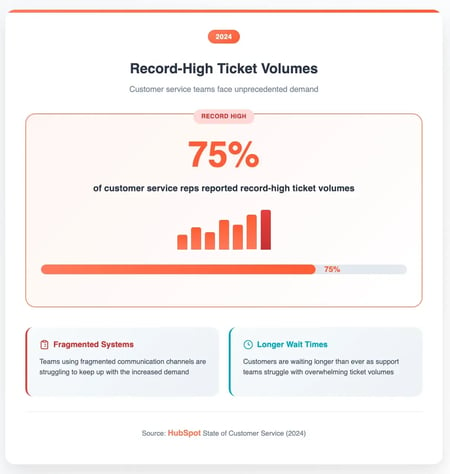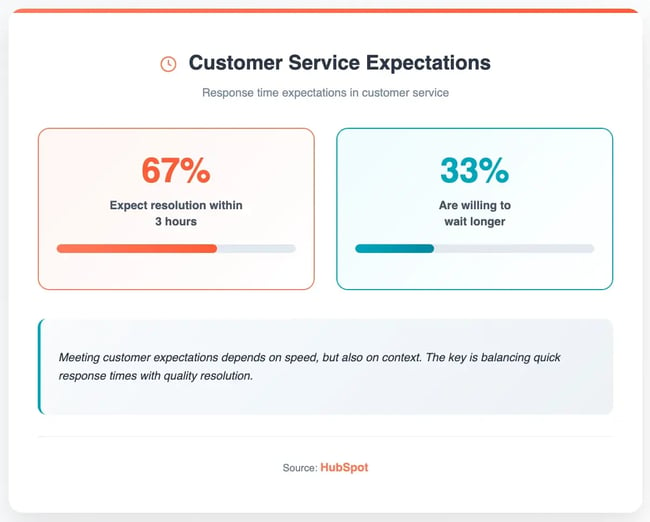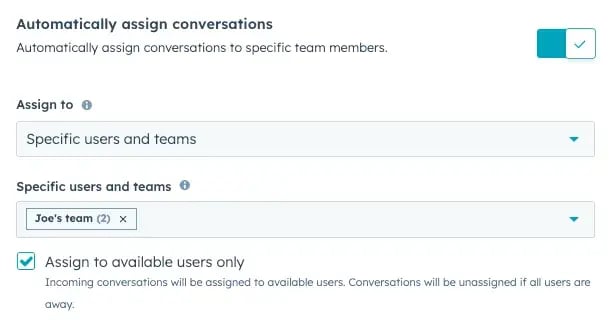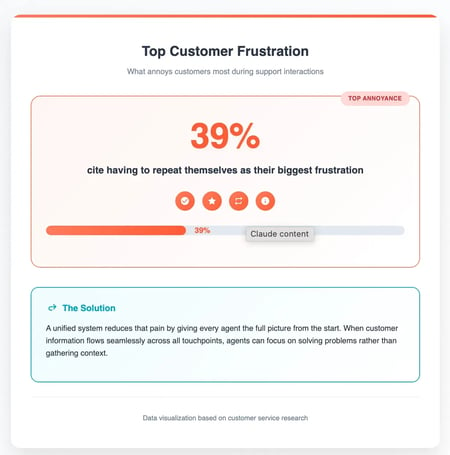Every year, customers ask more from support teams. They want quicker replies, seamless handoffs, and answers that feel personal across every channel. That rising bar makes the job harder. Agents burn out chasing context, while customers grow impatient when they have to repeat themselves.
The scale of the challenge is only increasing. Gartner predicts 30% of Fortune 500 companies will handle service through a single, AI-enabled channel by 2028. This makes perfect sense as consolidation isn’t optional. It’s inevitable. D2C brands need unified ticketing to handle high-volume support requests.
For brands fielding 10,000 or more support tickets each month, a consolidated system creates more than efficiency. Tools like HubSpot Service Hub avoid duplication, give agents the full story, and help leaders forecast where surges will hit next. Most importantly, it delivers what customers actually want: Fast, consistent support from a team that understands them.
Table of Contents
- Support Consolidation Challenges
- The Benefits of Unified Ticket Management
- How to Unify Support Tickets Across Email, Chat, and Social — A Guide for D2C Brands With Over 10,000 Monthly Tickets
- How Different Tools Manage Support Tickets
- Handling High-Volume and Seasonal Surges
- Frequently Asked Questions
Support Consolidation Challenges
1. Traditional help desks fail for modern D2C brands.
Traditional help desks weren’t built for the pace and complexity of D2C, where customer questions arrive not only through the website and email, but now also via Instagram DMs, TikTok comments, and countless other touchpoints. Nor were they designed to handle the volume of requests that comes from smartphone usage.
This is confirmed in HubSpot’s State of Customer Service, with 75% of customer service reps saying they noted record-high ticket volumes in 2024. Teams that use fragmented communication channels are struggling to keep up — and customers are waiting longer than ever, too.

Pro tip: HubSpot Service Hub’s omnichannel communication capabilities meet customers wherever they are by providing personalized support across every channel. The tool’s mobile inbox keeps teams productive on the go with tools to collaborate and deliver agile support.
2. There are hidden costs of siloed support systems.
When support channels operate in silos, the true cost often goes unnoticed until it snowballs. Duplicate support tickets, fragmented data, and wasted hours create barriers to delivering a consistent customer experience. For D2C brands managing high-volume interactions, that fragmentation quickly turns into a hidden drag on both efficiency and customer trust.
Nikita Sherbina, co-founder and CEO of AIScreen, told me this was one of the biggest challenges his team faced.
“We had email, chat, Instagram DMs, and even TikTok comments coming in daily. Each lived in its own silo, so a single customer could contact us three different ways about the same order, and three different agents would respond,” he explains.
Ticket counts were inflated by as much as 25% and customers were left frustrated by mixed replies. Sherbina told me that the deeper cost wasn’t “just” wasted time, but weakened decision-making. Without a unified customer view, they couldn’t spot issues early, and by the time they connected the dots, customer sentiment was already going down.
Pro tip: Service Hub’s Fully Integrated Smart CRM gives support teams instant access to every customer interaction, deal stage, and marketing touchpoint in one connected system. No more guesswork and context-switching that slows down resolution times.
3. Consolidation requires data privacy and security.
Consolidation is not only a tech hurdle. The process also demands strict control over customer data. Pulling support tickets into one platform requires secure storage, clear audit trails, and controlled access to Personally Identifiable Information (PII). So, the stakes extend far beyond efficiency.
Cassie Downing, director of customer experience at 3 Men Movers, told me her team faces this issue every summer. They handle close to 12,000 interactions across phone, email, live chat, and social channels. More than a third come from social DMs.
“Our Instagram DMs revolve around urgent day-of-move changes. TikTok comments are about quote requests within minutes of a trending post,” she says. These channels do not sync into their main system because of API restrictions, and leadership will not approve workarounds until they see stronger safeguards for sensitive data.
As a result, the team manages four platforms separately and spends an extra 90 seconds per interaction. Scaled across thousands of tickets, that costs them more than 40 hours every week.
The Benefits of Unified Ticket Management
1. You gain centralized channel visibility.
Multiple channels create silos, which a unified system solves. When support conversations sit in different inboxes — email in one, chat in another, social somewhere else — agents waste time piecing together fragments of the same issue. A unified view eliminates that disconnect and puts the entire customer story in front of the team.
Leaders already see how important this shift is. In HubSpot’s State of Customer Service 2024, 64% said they plan to invest in making their CRM a single source of truth.
Sara Cooper, director of strategy at AroFlo, told me how this change played out for her company in practice.
“The biggest advantage of a consolidated inbox is that it gives you a single source of truth. In our case, a technician might call, then send an email with screenshots, and later reply on chat, all for the same issue,” Cooper says.
Cooper notes that in the past, those were treated as three separate support tickets, which made it harder to spot the real urgency. “Once we brought everything into one view, the team could see the full history instantly, cut resolution time by almost half, and focus on fixing the issue instead of piecing the story together,” she says.
For AroFlo, the improvement wasn’t just speed. Cooper noted that seeing the full picture gave customers confidence that the support team understood their situation, not just their latest message.
2. You can leverage automated routing & prioritization.
With enterprise customers, not every request carries the same weight. Some are routine questions, while others are system-down emergencies. Before consolidation, those urgent issues could easily get buried under smaller requests scattered across email, chat, and social. A unified view can drastically improve visibility.
Pro tip: Service Hub’s automated customer service helps teams solve issues faster with AI-powered automation. AI can handle routine tasks and support requests, while intelligent routing ensures high-priority support tickets reach the right agents immediately.
Peter Barnett, CEO of Action1, has seen this play out firsthand. “Before consolidation, urgent tickets could get buried under smaller requests that came in through different channels,” he says.
Once everything was in a single view, Barnett says his team could instantly spot and escalate the most critical cases. “That shift not only improved our average response time for high-priority tickets by over 30%, but it also gave customers peace of mind that we understood their business impact and acted fast,” he says.
During flash sales or peak demand periods, this kind of automated routing becomes even more valuable. The system identifies VIP customers and routes them into priority flows, giving them the fastest path to resolution while freeing the team from manual triage in real time.
3. You create context-rich conversations and a consistent brand voice across channels.
Support teams hit walls when they work in silos. If agents can’t see the full customer journey, they treat every ticket like a blank slate. Knowing how someone discovered the brand, what they’ve bought, or their past support history can provide essential context for a better experience.
Matt Bowman, CEO and founder of Thrive Internet Marketing Agency, sees this all the time.
“Siloed support systems create massive inefficiencies when customer service teams can’t view the complete customer journey,” Bowman says. “The hidden costs become enormous when support agents provide solutions without understanding how customers discovered the brand or their previous engagement history.”
He recalled working with a D2C brand that fielded thousands of messages each month across email, Instagram, TikTok, and live chat. The team had little visibility into customers’ marketing interactions or purchase history.
“Support agents would explain product benefits to customers who had already seen detailed content on social media, or offer basic troubleshooting to VIP customers who deserved premium support. That context gap slowed resolutions and dragged down satisfaction scores,” Bowman says.
Customers notice this disconnect. They expect brands to remember where they’ve been, what posts they’ve engaged with, what emails they’ve opened, and what issues they’ve raised before.
When someone who’s interacted with ten Instagram posts asks a product question in DMs, they don’t want a copy-paste answer. They expect a response that reflects the relationship they’ve already built. Without integrated data, agents can’t deliver that, and both the customer and the support team suffer.
4. You generate faster response times.
A consolidated inbox does more than tidy up workflows; it buys back hours. Unified systems can cut response times by as much as 97%. That matters because customers are impatient. According to HubSpot, 67% expect resolution within three hours, while nearly a third are willing to wait longer. Meeting those expectations depends on speed and context.
Before unifying systems, Styletrende’s agents lost almost a third of each shift just toggling between tabs for email, social, and chat.
Roman Hayes, who leads customer experience at the company, explained that once every interaction — from WhatsApp to Instagram DMs — flowed into the same dashboard, response times dropped by 40%. Tickets came in tagged and prioritized automatically, so the team could focus on solving problems instead of finding them.

Hayes noted that the real advantage showed up in personalization. With full visibility into order history, past complaints, and preferred channels, agents could tailor their responses, reducing repeat contacts.
For leadership, a unified system also unlocked cleaner analytics, which showed which campaigns drove ticket spikes, which channels created the most volume, and where automation could ease the load.
Pro tip: AI can help increase visibility in service interactions. Service Hub’s Conversation Intelligence learns from every customer interaction with AI-powered analytics, helping teams continuously improve their response quality and personalization.
How to Unify Support Tickets Across Email, Chat, and Social — A Guide for D2C Brands With Over 10,000 Monthly Tickets
1. Audit existing support channels.
The first step is to get a clear picture of the channels where customers reach out. Support teams should take stock of every channel they use, including email, live chat, phone, WhatsApp, Instagram DMs, or even in-app chat. Look at how many support tickets each channel generates, how quickly teams respond, and what types of questions keep coming up.
In HubSpot Service Hub, users can pull these insights straight from reporting dashboards and the conversations inbox, which makes it easy to see the busiest channels and spot any weak points. This simple audit gives service teams the foundation to decide which channels to keep, which to streamline, and how to bring them together into one workflow.
2. Configure HubSpot’s conversations inbox.
HubSpot Service Hub consolidates tickets, which improves response time. Emails, chats, and social messages flow into a single feed, helping your team respond faster and avoid duplicate work.
Here’s how.
Step 1: Connect your brand email to the inbox.
When service teams link their brand email, all incoming messages appear in one place. With Service Hub, agents no longer need to switch between platforms, so replies happen faster and ticket tracking becomes effortless. Instructions for connecting email are available on HubSpot’s conversations inbox setup page.
How to set up the conversations inbox in HubSpot.
Step 2: Link chat widgets and social accounts.
Messages from web or mobile chat, Facebook Messenger, WhatsApp, and other social channels can flow into the same inbox. This allows teams to manage all conversations in HubSpot Service Hub.
Go to Settings > Inbox > Inboxes, click “Connect a channel,” and see instructions for each channel teams can draw data from.
Step 3: Map Shopify or WooCommerce order data.
Next, integrate Shopify or WooCommerce with Service Hub to add customer and order details to each conversation. After, service agents will be able to see purchase history and other context directly in the inbox.
There are individual Shopify and WooCommerce integration step-by-step instructions for you to follow. Third-party tools like Zapier can extend workflows further if needed.
Step 4: Define routing rules for VIPs and flash sales.
Service Hub can automatically assign conversations to the right team member. Routing ensures that VIP customers or urgent flash-sale inquiries go to the most appropriate agent, so that priority messages never get lost.

By consolidating channels, surfacing order data, and automating routing, Service Hub helps teams work smarter, respond faster, and give customers a seamless support experience. All from one central inbox.
3. Train your support team and set SLAs.
If your D2C brand handles 10,000+ support tickets a month, training your support team and setting clear Service Level Agreements (SLAs) is critical. Training builds a smooth operation and prevents service agent overload. Here’s how to get it right.
Step 1: Create response templates.
Start by reviewing the questions that appear most often — shipping delays, returns, or product issues. Then, draft on-brand responses. Here are a couple of examples:
- For shipping delays: “Hi [First Name], thanks for reaching out! Your order [Order #] is on its way and should arrive by [Date]. We appreciate your patience during this busy period.”
- For return requests: “Hello [First Name], we’ve received your return request for [Product]. Please use this prepaid label [link], and we will process your refund within 3-5 business days.”
Service Hub’s AI-powered features can automatically suggest reply recommendations and provide automated ticket summaries. These suggestions can help agents craft personalized responses faster while maintaining brand consistency.
From there, use personalization with AI ticketing mechanisms, so messages feel personal without extra typing. Organize templates by category (shipping, returns, product troubleshooting) so service reps can find them quickly. Be sure to update templates whenever policies or products change.
Step 2: Run simulated high-volume drills.
Test service teams before real peak periods hit:
- Create scenarios that mimic busy times, like holidays, flash sales, or product launches.
- Assign roles so everyone knows what to handle during spikes.
- Track performance. Measure response times, resolution rates, and watch for bottlenecks. For example, run a flash sale drill where the team handles payment errors, coupon questions, and VIP inquiries simultaneously.
- Debrief and improve. Review what worked, adjust templates, tweak workflows, and refine SLAs so the real event runs smoothly.
Solid templates and practice drills help service teams stay consistent, respond quickly, and hit SLA targets, even during the busiest periods. Preparation prevents chaos when ticket volume spikes.
4. Monitor Performance and Refine Workflows
Once the team is trained and SLAs are in place, service leaders should track performance and improve workflows continuously.
Step 1: Track key metrics.
Measure first response and resolution times to ensure your team meets SLA targets and to catch any slowdowns early. Look at ticket volume by channel to allocate resources efficiently. Keep an eye on customer satisfaction scores, like CSAT and NPS, to spot trends and maintain happy customers.
Service Hub’s Feedback Management helps you understand what customers really think with customizable NPS, CSAT, and customer surveys. Feedback automatically integrates with your support data for comprehensive performance insights.
Step 2: Spot trends and bottlenecks.
Identify recurring issues that generate high ticket volumes, such as common product questions or frequent order problems. Check for slow channels or team members and adjust responsibilities as needed. Review templates and training materials to find responses that require improvement or additional guidance.
Step 3: Refine workflows.
Update routing rules for VIPs, flash sales, or other priority segments so the right tickets reach the right team members. Revise templates whenever new issues appear or policies change. Adjust team schedules and SLA targets to match actual ticket volume and peak periods. This will help you keep support operations efficient and responsive.
How Different Tools Manage Support Tickets
Feature Area | HubSpot Service Hub | Zendesk | Freshdesk |
Data Unification & Team Silos | Built on one platform with CRM at the core. Every customer interaction (marketing, sales, service) lives in a single record for real-time collaboration across teams. | Built from acquisitions. Data and tools are less unified, creating silos between departments. | Customer data is often fragmented unless businesses also buy into the broader Freshworks suite. |
Customer Success Tools | Dedicated workspace for success teams, health scores & alerts, playbooks, and proactive retention features built in. | Focused on case management. | Lacks built-in success features unless extended with Freshworks add-ons. |
Insights, Reporting & Automation | Unified CRM and automation across departments. Example: a ticket tagged “churn risk” can trigger alerts for Sales, workflows for Success, and a feedback survey automatically. | Strong core support workflows, but lacks cross-department automation. | Offers help desk reporting, but without unified CRM integration; full automation only comes with additional Freshworks modules. |
AI & Scaling Capabilities | AI-powered “Customer Agent” handles tickets 24/7, omnichannel inbox, plus unified document management. | AI is available but typically as paid add-ons. | AI and advanced multichannel capabilities often require Freshworks’ Freddy AI or other products. |
Support Request Management | Unified pipelines, omnichannel routing, SLAs, tasks, surveys, conversation intelligence, and collaboration all in one place. | Provides ticketing and multichannel support but lacks advanced features like custom ticket pipelines or unified reporting. | Functional as a help desk, but richer context requires expansion into the Freshworks ecosystem. |
Best for: | D2C brands with 10,000-50,000 monthly tickets needing scalable, unified support tied to marketing and sales for retention. | Brands with 5-20 support agents across channels that want reliable ticket handling but don’t need deep CRM/success integration. | Companies selling on multiple platforms (Shopify, Amazon, own site) that need flexible channel coverage but are okay with piecing together the broader stack. |
Handling High-Volume and Seasonal Surges
1. Flash Sale Support Strategies
Flash sales put support teams under pressure. Ticket volume can spike 400% in minutes, and without a plan, customer experience unravels just as fast. One of the biggest frustrations for customers is having to repeat themselves, with 39% citing it as their top annoyance. A unified system reduces that pain by giving every agent the full picture from the start.

Moattar Ali, VP of marketing at HARO Links Builder, has managed D2C support operations for brands processing more than 15,000 tickets a month. His playbook for seasonal surges relies on consolidation and smart routing.
Ali explained that predictive ticket routing makes the first cut. “We pre-route 60% of flash sale questions for human review before processing,” he says.
The team also prepares templated replies for the twelve most common flash sale queries, crafted to stay true to the brand’s voice. That preparation means agents can turn around responses in as little as four seconds.
Social commerce requires an even sharper edge. Ali builds rapid-response teams trained specifically on Instagram Shopping and TikTok Shop order flows. That specialization really works. Of social commerce questions, 89% get resolved without escalation. Even under peak load, the team keeps conversations personal, never robotic.
Consolidation tools accelerated response times by 73%, cut flash sale support costs in half, and lifted satisfaction scores from 3.1 to 4.7 stars. For brands that live and die by seasonal moments, that difference can define the entire year.
3. Maintaining Brand Voice at Scale
When customers use every channel at once, service teams risk duplicate communication. Jason Rowe, Director and Founder of Hello Electrical, knows what it feels like.
“In the absence of a consolidated view, three separate personnel might be pursuing one and the same employment,” he explains. In one week alone, that overlap cost the company more than $300 in wasted travel.
The strain intensifies during seasonal peaks. In summer, air conditioning call-outs jump nearly 40%. And, in January of last year, Hello Electrical’s office logged more than 220 calls in a single week, and this excludes texts and social media messages.
Rowe said that under those conditions, brand consistency suffers. Customers receive uneven updates, and in a trust-based industry, that lack of clarity quickly kills loyalty.
A unified ticketing system helps handle such situations. By channeling every message into one queue, Hello Electrical removed redundancy, cut response times, and gave agents the ability to use a consistent voice.
For Rowe, that consistency strengthened credibility and showed professionalism across every customer touchpoint.
Pro tip: Service Hub’s knowledge base agent automatically fills content gaps and ensures consistent messaging across all channels. Sentiment analysis helps maintain appropriate tone even during high-stress periods.
3. Building Forecasting Mechanisms
Seasonal spikes can overwhelm even the best support teams, but forecasting turns those surges into something predictable and manageable.
Barbara Robinson, marketing manager at Weather Solve, explained how this approach transformed her team’s harvest-season operations.
Ticket volume at Weather Solve jumps from 350 to more than 600 per week when farms rush to install hail canopies. Robinson built a forecasting model that factors in weather data, past installation timelines, and distributor sales orders. With that foresight, she sets routing rules in advance. Technical tickets go directly to engineers, while trained temporary staff handle general inquiries.
In 2023, the harvest backlog swelled to more than 900 tickets, and response times stretched to 36 hours.
After the company introduced forecasting and routing, the 2024 season brought 70% more tickets. However, average response time dropped to 11.8 hours, and backlog never rose above 200. That preparation kept clients on schedule through the busiest six weeks of the year.
Frequently Asked Questions
How should teams handle support during flash sales?
Flash sales create spikes in inquiries, and the key is to prepare the system and team before the rush hits. HubSpot Service Hub automatically tags and routes sales-related requests to a dedicated queue. This ensures that agents with the right skills — such as knowledge of promotions, returns, or shipping delays — are the ones who see them first.
AI-driven chatbots can deflect the most common questions, like “Where is my order?” or “Is the discount still active?”, leaving human agents free to manage more complex or sensitive cases.
What about Instagram Shopping support messages?
Instagram Shopping messages should flow directly into a central support inbox alongside email and chat. This allows agents to respond in-channel without switching tools, while still seeing customer history and order details from the CRM. The process creates a seamless experience for both shoppers and the support team.
How can I maintain brand voice across channels?
Customers expect the same tone whether they reach you on email, chat, or social. Build playbooks with pre-approved phrasing, train agents with examples, and use AI to draft responses. Then, use regular quality reviews to guarantee alignment with brand identity.
Service Hub’s multi-language support ensures a consistent customer experience across global markets, with automatic language detection and localized response templates that maintain brand voice in every market.
How can I prioritize VIP customers in a unified system?
Mark VIPs in the CRM based on spend, loyalty, or subscription tier. Route their tickets directly to senior agents or dedicated queues and enforce stricter SLAs so they always receive faster attention. This approach makes business’ most important customers feel recognized and valued.
Service Hub’s customer success workspace helps managers build unique customer health scores and prioritize team activities during these high-volume scenarios. That helps service teams ensure that the most critical customers receive appropriate attention.
How should I prepare a support team for channel consolidation?
Channel consolidation requires both the right tools and team readiness. Train agents to work from a unified inbox, roll out new channels in stages, and standardize workflows to reduce friction. With clear processes in place, the team can handle every interaction consistently, no matter the channel.
Deliver consistent, high-quality support – regardless of ticket volumes.
Handling tens of thousands of tickets across email, chat, and social doesn’t have to feel chaotic. Start by auditing existing service channels and training reps with clear templates and SLAs. Then, monitor their performance continuously to refine workflows as support volume grows.
HubSpot Service Hub’s comprehensive platform combines AI-powered automation, omnichannel communication, and unified customer data to help teams scale support operations while maintaining the personal touch that drives customer loyalty and retention.
Bringing all these pieces together helps teams respond faster, reduce duplicated work, and create a seamless experience for customers.
Unify D2C support with HubSpot’s Conversations Inbox in Service Hub and see how centralized ticketing can transform operations.
![]()


![Access Now: Customer Support Strategy Template [Free Tool]](https://no-cache.hubspot.com/cta/default/53/7dff7d77-3a4c-40ea-a4c8-376b827a83ab.png)
Leave a Reply